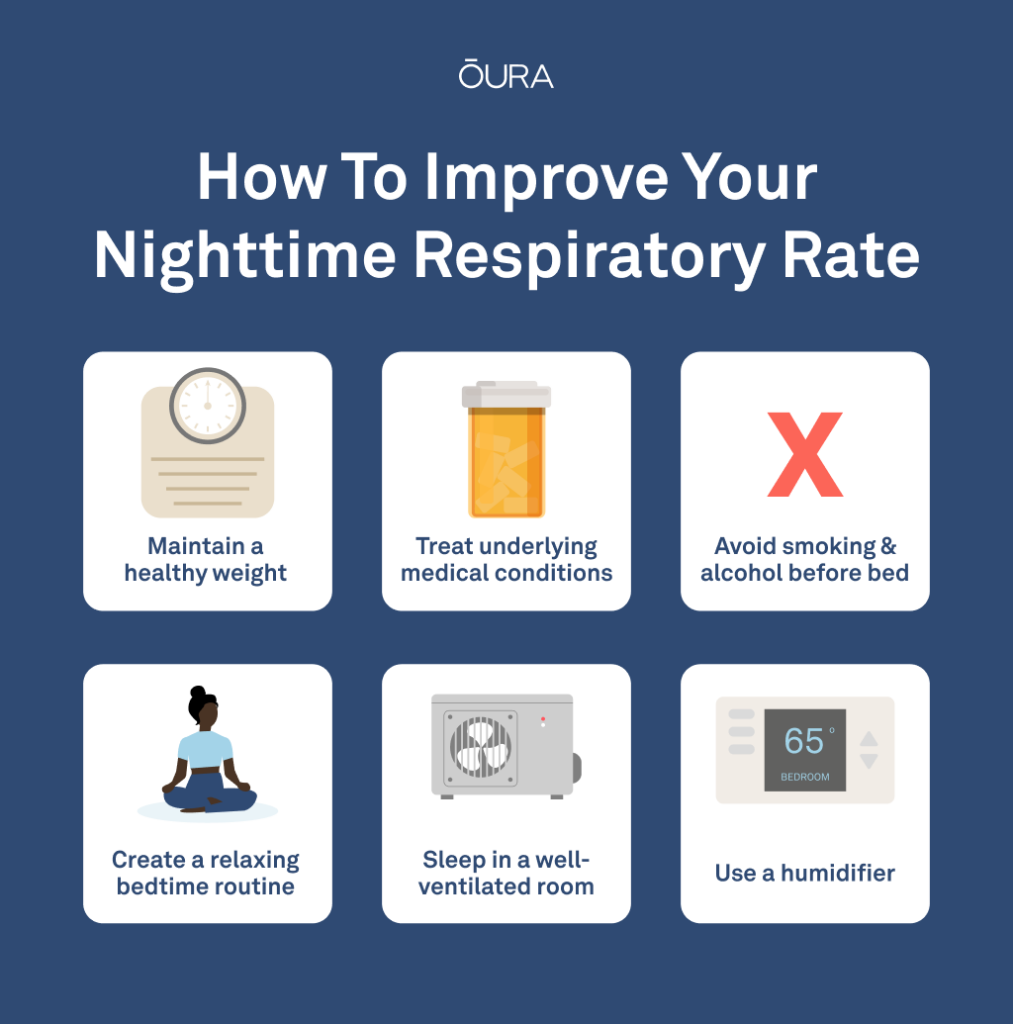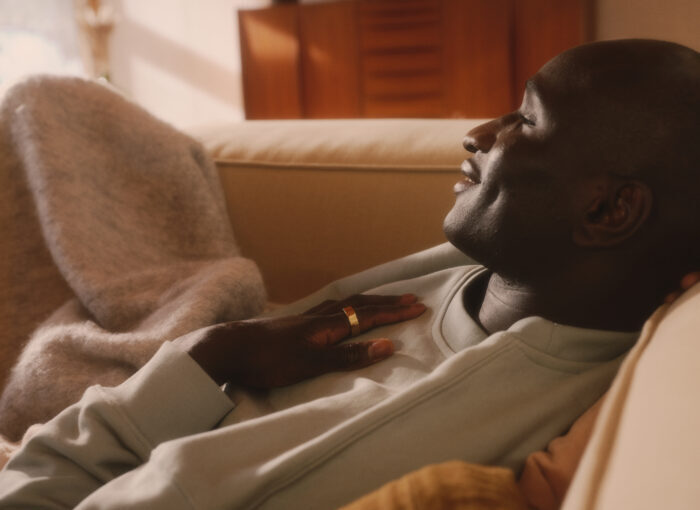- The number of breaths you take per minute (brpm) can offer crucial insights into your overall health and well-being.
- The average normal breathing rate while sleeping varies by age, and it’s highly individualized.
- Tracking and monitoring your respiratory rate trends over time can help you detect abnormalities quickly. Oura makes it simple to do this.
Respiratory rate, or breathing rate, is the number of breaths you take per minute. Your waking and nighttime respiratory rates are both primary vital signs and key health indicators. An elevated or abnormally low respiratory rate usually means something is challenging your system.
It’s crucial to understand the various factors that affect your respiratory rate, including sleep. When you fall asleep, your breathing naturally changes — your body’s metabolic rate slows, and less oxygen is needed.
Your breathing rate while sleeping also varies depending on the sleep stage. During deep sleep, the rate is at its slowest. In REM sleep, characterized by increased brain activity and quick eye movement, respiratory rate increases and becomes more irregular.
Learning more about your nighttime respiratory rate and monitoring changes can alert you to changes in your physical fitness, health, or hormone cycle.
| Member Tip: The respiratory rate displayed in your Oura App shows how many breaths you took per minute (brpm) during the previous night, on average. |
What Is a Normal Respiratory Rate (Brpm) During Sleep?
Average respiratory rates vary by age. Young children have higher rates, which progressively decrease as they get older and enter adulthood.
| Age | Respiratory Rate Range (breaths/minute or brpm) |
| Birth to 6 months | 30 to 60 |
| 6 months to 1 year | 30 to 50 |
| 1 to 3 years | 24 to 40 |
| 3 to 5 years | 22 to 34 |
| 5 to 12 years | 16 to 30 |
| 12 years and up | 12 to 20 |
A typical nighttime respiratory rate for healthy adults is 12–20 breaths per minute. However, your respiratory rate is highly individualized and may change over time, so be sure to track and compare it to your own averages; avoid comparisons to those around you.
Tracking your respiratory rate trends over time allows you to spot any abnormalities. Typically, changes in your average respiratory rates are quite small (within 1–2 breaths per minute). Changes beyond this can indicate an abnormally high respiratory rate (tachypnea) or an abnormally low one (bradypnea).
READ MORE: What is the Relationship Between Heart Rate and Respiratory Rate?
What Causes an Abnormal Breathing Rate (Brpm) While Sleeping?
Tachypnea is rapid breathing above 20 breaths per minute. It can be caused by factors such as:
- Exertion: Exercise or other physical activity can cause an increase in respiratory rate.
- Anxiety and stress: Rapid and irregular breathing patterns are associated with increased anxiety and stress.
- Pain: Severe pain often results in shallow breathing (since deep breathing can aggravate pain), muscle tension, and anxiety, which can all cause rapid breathing.
- Fever: Fever increases respiration rate because the body needs more oxygen to regulate body temperature and support increased metabolic activity.
- Lung conditions: Chronic obstructive pulmonary disease (COPD), asthma, chronic bronchitis, lung cancer, pneumonia, and other lung conditions often make breathing difficult, leading to a high breathing rate while sleeping.
- Heart conditions: Heart conditions such as congestive heart failure and arrhythmia can affect the respiratory rate and lead to tachypnea during sleep.
- Metabolic conditions: Metabolic conditions, such as diabetic ketoacidosis, a diabetes complication that develops when the body produces too little insulin and excess blood acids (ketones), can cause rapid breathing and a high respiratory rate.
- Medications: Certain medications like corticosteroids and bronchodilators are associated with increased breathing rates during sleep.
Common tachypnea symptoms include sharp chest pain when inhaling, shortness of breath, dizziness, confusion, and pressure in the chest that worsens over time. On the other hand, bradypnea is typically defined as less than 12 breaths per minute. It can be caused by:
- Sleep apnea: Obstructive sleep apnea, a disorder in which breathing repeatedly stops and starts during sleep, can lead to a low breathing rate, as well as other health problems such as snoring, fatigue, daytime sleepiness, and high blood pressure.
Member Tip: Oura members can use the Blood Oxygen Sensing (SpO2) feature to track how efficiently their bodies circulate and absorb oxygen, allowing them to detect any possible breathing disturbances during the night. Oxygen levels below 95% are a sign to seek medical attention. RELATED: 6 Sleep Apnea Myths, Debunked
- Alcohol consumption: Alcohol can slow down respiratory rate, especially in large amounts.
- Stress and anxiety: Long-term stress and anxiety can result in an abnormally low respiratory rate.
- Health conditions: A metabolic condition such as hyperthyroidism can affect your metabolism and breathing ability. Similarly, heart problems and head injuries can cause abnormally slow breathing.
- Medications: Opioids and sedatives are examples of medications that can slow down respiratory rate.
- Hormonal shifts: Hormones can cause respiratory rate variability, particularly in women. This is because respiratory rate trends correlate with menstrual cycles. Respiration is slower at the beginning of the cycle (follicular phase) and speeds up towards the end (luteal phase).
Common bradypnea symptoms include fatigue and weakness, dizziness, shortness of breath, confusion, and chest pains. If you are concerned about your breathing rate, it’s important to talk to your healthcare provider. They can help you to identify the underlying cause and develop a treatment plan to improve your sleep quality and overall health.
How Can You Improve Your Nighttime Respiratory Rate?
In addition to seeing a doctor and treating any underlying causes of abnormal breathing, the following tips can help you improve your respiratory rate:
- Maintain a healthy weight. Excess weight can put pressure on your airways and make it more difficult to breathe.
- Avoid smoking and secondhand smoke. Smoking irritates the airways and can make it more difficult to breathe.
- Avoid alcohol before bed. Alcohol can relax airways and throat muscles, leading to breathing problems during sleep.
Member Tip: Oura members can use Tags to track how alcohol consumption before bed affects your sleep quality. Over time, you can visualize the impact using your Trends chart. - Create a relaxing bedtime routine. A relaxing bedtime routine can help you wind down and prepare for sleep. For example, meditation and listening to sleep sounds can reduce stress and anxiety, resulting in a more stable breathing rate during sleep.
Member Tip: Oura members can view Explore content within the Oura App to access guided meditation content and post-session biofeedback to gauge how well their bodies respond to the meditation. - Sleep in a well-ventilated room. A well-ventilated room will help ensure that you have enough oxygen to breathe.
- Use a humidifier. A humidifier can add moisture to the air, making breathing easier and reducing the risk of snoring.

Things to Keep in Mind
It’s essential to recognize that your respiratory rate and heart rate variability (HRV) are closely tied — your heart rate experiences fluctuations during your breathing cycle.
Specifically, when you breathe more slowly and deeply, your HRV tends to increase. This is because slower, deeper breathing activates the parasympathetic nervous system, which is responsible for the body’s “rest and digest” state. Conversely, quick and shallow breathing tends to decrease HRV. Faster, shallower breathing activates the sympathetic nervous system, which is responsible for the body’s “fight or flight” response.
In general, a higher HRV is associated with a healthier cardiovascular system and a lower risk of chronic diseases such as heart disease, stroke, and diabetes. It’s also associated with better cognitive function, stress resilience, and sleep quality. Therefore, monitoring your long-term respiratory rate can reveal insights into your HRV and overall health.
FAQs About Respiratory Rate While Sleeping
What is a normal respiratory rate while sleeping?
For healthy adults, the normal respiratory rate while sleeping is typically 12–20 breaths per minute. This range is considered the normal sleeping respiratory rate and reflects how your body conserves energy at night.
How many breaths per minute while sleeping is normal?
If you’re wondering how many breaths per minute while sleeping is expected, the answer depends on age. Babies and young children breathe faster — up to 30–60 breaths per minute sleeping — while adults average 12–20 average breaths per minute while sleeping.
What should my respiratory rate be while sleeping?
Your sleep respiratory rate is highly individual. While the general range is 12–20, it’s best to compare changes against your own baseline. A consistent shift from your typical breath rate while sleeping may be a sign to check in with your doctor.
What is a good respiratory rate while sleeping?
A good respiratory rate while sleeping usually falls within the healthy adult range of 12–20. Athletes or highly fit individuals may have a slightly lower brpm while sleeping, while stress, illness, or medical conditions can push your sleeping respiratory rate higher or lower.
What causes a high breathing rate while sleeping?
A high breathing rate while sleeping (tachypnea, over 20 brpm) can be caused by anxiety, fever, pain, lung conditions (like asthma or COPD), heart issues, or metabolic disorders. If your high respiratory rate while sleeping is persistent and paired with symptoms such as chest pain, dizziness, or shortness of breath, seek medical attention.
What causes a low respiratory rate while sleeping?
A low respiratory rate while sleeping (bradypnea, below 12 brpm) can result from sleep apnea, alcohol or sedative use, stress, heart conditions, or neurological issues. Consistently low brpm during sleep can affect oxygen levels, so it’s important to discuss with a healthcare provider.
What is normal respiratory rate while sleeping for children?
Children have naturally higher respiratory sleep rate values. For example, infants breathe 30–60 breaths per minute sleeping, while toddlers may average 24–40. By adolescence, the normal breaths per minute while sleeping gradually decreases toward the adult range.
Why does respiratory rate change during sleep stages?
Your respiratory rate while sleeping shifts with sleep phases. It’s slowest during deep sleep, when your body is most relaxed, and becomes faster and more irregular during REM sleep, when brain activity increases. Monitoring these changes helps you understand your overall sleep respiratory rate patterns.
How can I improve my sleeping respiratory rate?
To support a healthy sleeping respiratory rate, try maintaining a healthy weight, avoiding alcohol before bed, quitting smoking, and practicing relaxation techniques. Sleeping in a ventilated room or using a humidifier may also help stabilize your brpm while sleeping.
RELATED: At 66, This Oura Member Doubled His HRV and Improved His Health — Here’s How




